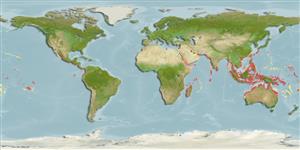Common names from other countries
Environment: milieu / climate zone / depth range / distribution range
Ecología
marino; agua dulce; salobre demersal; catadromo (Ref. 46888); rango de profundidad 0 - 5 m (Ref. 86942). Tropical; 30°N - 35°S, 24°E - 138°W
Indo-Pacific: Persian Gulf (Ref.80050) and Red Sea to Samoa, north to Japan. Collected at Natal, South Africa (Ref. 11228).
Tamaño / Peso / Age
Maturity: Lm ? range ? - ? cm
Max length : 40.0 cm SL macho / no sexado; (Ref. 9812); common length : 25.0 cm TL macho / no sexado; (Ref. 9812)
Espinas dorsales (total) : 4 - 5; Radios blandos dorsales (total) : 8 - 9; Espinas anales: 3; Radios blandos anales: 9. Dark greenish dorsally, brownish over head, white ventrally; 3-6 indistinct, dark stripes along upper rows of scales; greyish dorsal fins; caudal fin bluish with black margin (Ref. 9812). Yellowish pectoral fin and may have a blue spot at fin origin (Ref. 9812).
Form schools in shallow coastal waters and enters lagoons, estuaries, and fresh water to feed (Ref. 9812). Juveniles may enter rice fields and mangroves (Ref. 9812). Feed on small algae, diatoms and benthic detrital material taken in with sand and mud; fry take zooplankton, diatoms, detrital material and inorganic sediment (Ref. 9812). Oviparous, eggs are pelagic and non-adhesive (Ref. 205). Spawning occurs at sea. Also caught with stakenets (Ref. 9812). Marketed fresh and salted.
Life cycle and mating behavior
Maturities | Reproducción | Spawnings | Egg(s) | Fecundities | Larva
Thomson, J.M., 1984. Mugilidae. In W. Fischer and G. Bianchi (eds.) FAO species identification sheets for fishery purposes. Western Indian Ocean (Fishing Area 51). volume 3. [pag. var.]. FAO, Rome. (Ref. 2830)
IUCN Red List Status (Ref. 130435)
CITES (Ref. 128078)
Not Evaluated
Threat to humans
Harmless
Human uses
Pesquerías: comercial; Acuicultura: comercial; carnada: usually
Herramientas
Special reports
Download XML
Fuentes de Internet
Estimates based on models
Preferred temperature (Ref.
115969): 25.2 - 29.3, mean 28.4 (based on 3436 cells).
Phylogenetic diversity index (Ref.
82804): PD
50 = 0.5078 [Uniqueness, from 0.5 = low to 2.0 = high].
Bayesian length-weight: a=0.01259 (0.01053 - 0.01505), b=2.93 (2.90 - 2.96), in cm Total Length, based on LWR estimates for this species (Ref.
93245).
Nivel trófico (Ref.
69278): 2.7 ±0.30 se; based on food items.
Resiliencia (Ref.
120179): Medio, población duplicada en un tiempo mínimo de 1.4-4.4 años (K=0.15-0.63).
Fishing Vulnerability (Ref.
59153): Low to moderate vulnerability (32 of 100).
